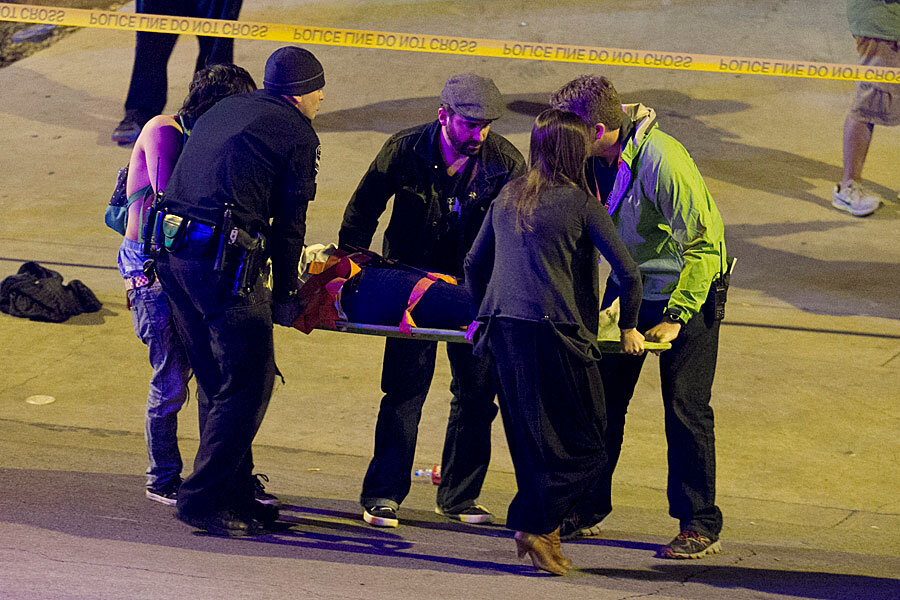SXSW car crash: Another case of police high-speed pursuit gone awry?
Loading...
Rashad Charjuan Owens was charged Friday with one count of capital murder after Austin police say the drunken-driving suspect accelerated into a crowd at the South By Southwest (SXSW) festival, killing two people and injuring 23 others.
Austin Police Chief Art Acevedo has said that Owens will face two capital murder charges, and as many as 23 counts of aggravated assault.
What happened, and was this another case of a high-speed police chase gone awry?
The city of Austin already faces a $1 million wrongful-death lawsuit filed earlier this month by the widow of a man killed when a suspect pursued by police crashed into the car driven by her husband.
James Williford was killed when Reynaldo Victor Hernandez Jr. plowed into his car with a stolen Ford pickup truck in 2012. Austin police chased Hernandez “weaving in and out of heavy afternoon traffic, through red lights, at speeds near 100 mph,” according to the lawsuit.
Hernandez was suspected of theft at Nordstrom, and police were alerted by Nordstrom and Barton Creek Mall security. Herenandez fled the mall in a stolen truck and police pursued him. Hernandez has since been convicted of murdering Williford.
The lawsuit is also seeking a change in the Austin Police Department's pursuit policy, reports Austin NBC-TV affiliate KXAN.
“The conduct of officers Sargent and Horn was not only negligent but also rose to the level of reckless disregard for the safety of others, because they knew or should have known that initiating and continuing the high-speed chase of Mr. Hernandez posed a high degree of risk of serious injury to others,” the lawsuit says. “In pursuing Mr. Hernandez, officers Sargent and Horn failed to drive with appropriate regard for the safety of all persons. Specifically, their conduct constituted reckless disregard for the safety of others as defined by Texas law because they knew or should have known that their conduct posed a high degree of risk of serious injury to others.”
Currently, the Austin police pursuit policy states: “Officers are authorized to initiate a pursuit when it is reasonable to believe that a subject is attempting to evade arrest or detention by fleeing in a vehicle.”
Seoanes Williford's lawsuit advocates that the Austin police limit high-speed chases to felony crimes or violent offenders. Property theft or drunk driving is not considered an offense that warrants a high-speed chase.
In the SXSW crash this week, according to the arrest warrant, Owens told police that he "got scared" when he saw police lights behind him around 12:30 a.m. Thursday because outstanding warrants meant he could go to prison for five years. The warrant says Owens said he's facing kidnapping warrants issued as part of a custody battle over his daughter, the Associated Press reports.
The police chase began after Owens, driving a Honda Civic with lights off, swerved in front of a police car patrolling for drunk drivers. Owens, according to a police affidavit, reports The Austin American Statesman, then cut through a gas station and sped the wrong way down a one-way street before crashing through police barriers blocking a street closed for South By Southwest festivities — forcing another police officer manning the roadblock on foot to dive out of the way.
Police say Owens then plowed into a crowd of concertgoers.
When the Austin police chief was asked if the police pursuit policy contributed to the incident, Rolling Stone reported that he said: "There is only one person who's responsible for this."
Other observers have noted that in this SXSW case its unlikely that either the police or the driver reached excessive speeds.
Reporting on high-speed police pursuits is inconsistent, resulting in incomplete data. But according to an FBI report in 2002, bystanders constitute 42 percent of persons killed or injured in police pursuits. A National Highway Traffic Safety Administration report said that crashes as a result of police pursuits kill on average one person a day. Of those killed, at least a third are innocent bystanders, according to PursuitSafety, an non-profit group that advocates against high-speed chases.
When asked about the SXSW crash, Candy Priano, executive director of PursuitSAFETY issued this statement: "Drunken driving is a public safety issue by itself; but when combined with police chases, the risk to the innocent bystander is obviously increased. Initiating a pursuit to pull over an impaired driver in the name of making the roads safer frequently risks doing exactly the opposite, hastening rather than preventing tragedy. PursuitSAFETY is working on developing all possibilities of improving safety in such dangerous situations, including better training, procedures and technologies."
Austin police are well aware of the risks associated with high-speed pursuits. This past year, they received a grant to be the first police force in Texas test out a dart tracking system called StarChase. "Officers can target the car they are chasing, lock in a laser sight to the suspect's bumper and launch a dart that will stick to the suspect's car. Inside the dart is a GPS tracking device. Officers can pull back from the pursuit, take some heat off the suspect and track his every move with computers back at the station," reported KEYE-TV in Austin.
Twelve cars were fitted with the dart tracking systems at a cost of $5,000 each. How well did it work?
In 2012, the Austin police reported 143 high-speed pursuits and 36 crashes. In 2013, the first year usng the StarChase system, there were 123 pursuits and 34 crashes. The number of crashes per pursuit rose. But of those 123 pursuits in 2013, 17 involved the StarChase system. "None of the pursuits that involved the deployment of StarChase has resulted in any type of injury or any type of vehicle crash," Austin Police Sgt. Stephen Fleming told KEYE-TV. "We've captured every suspect."
Flemming says they'd like to expand the StarChase system to more cars, and are seeking funding from the city budget.
[Editor's note: The original post incorrectly stated that Owens initially avoided a police DUI checkpoint.]






